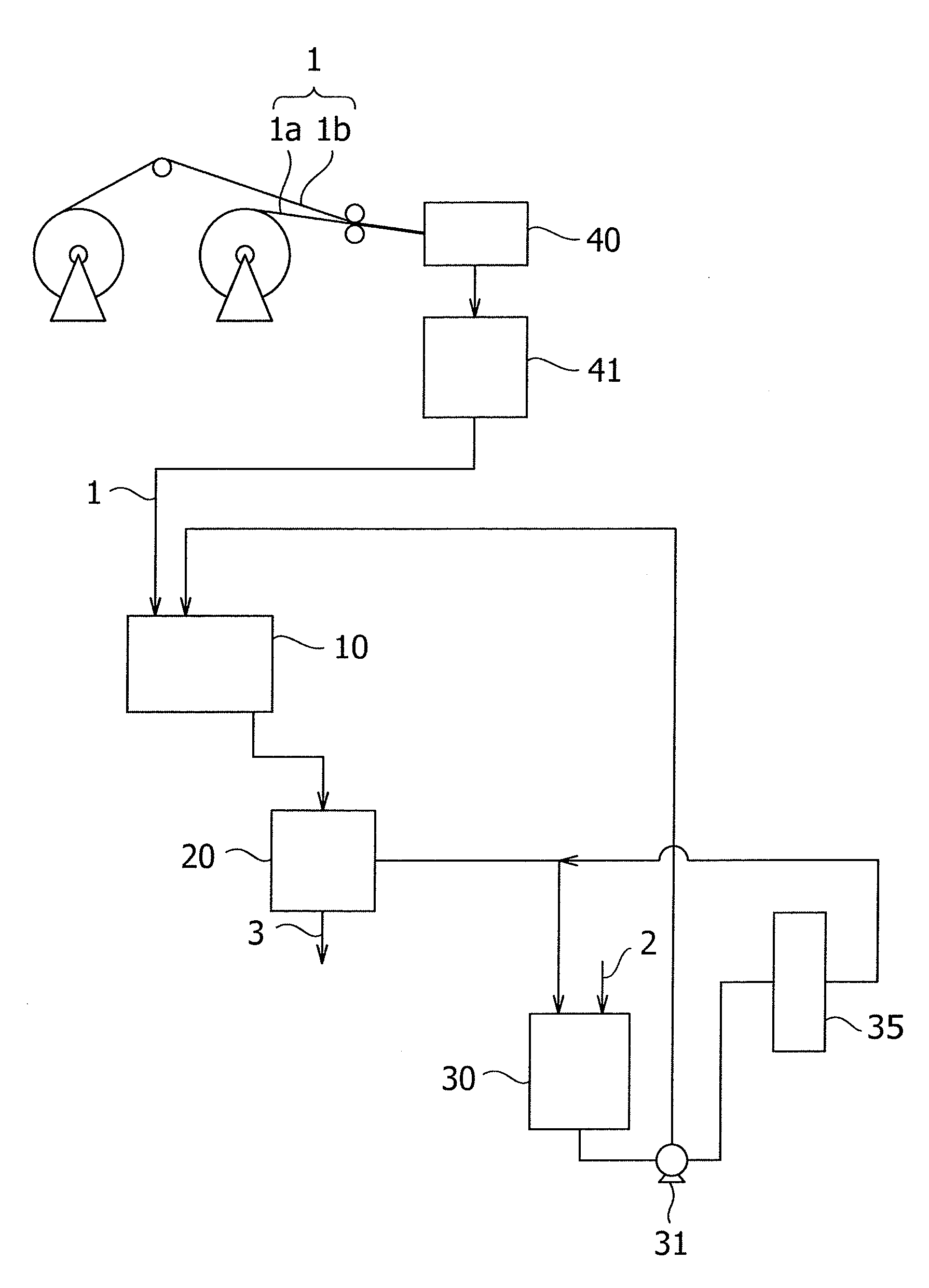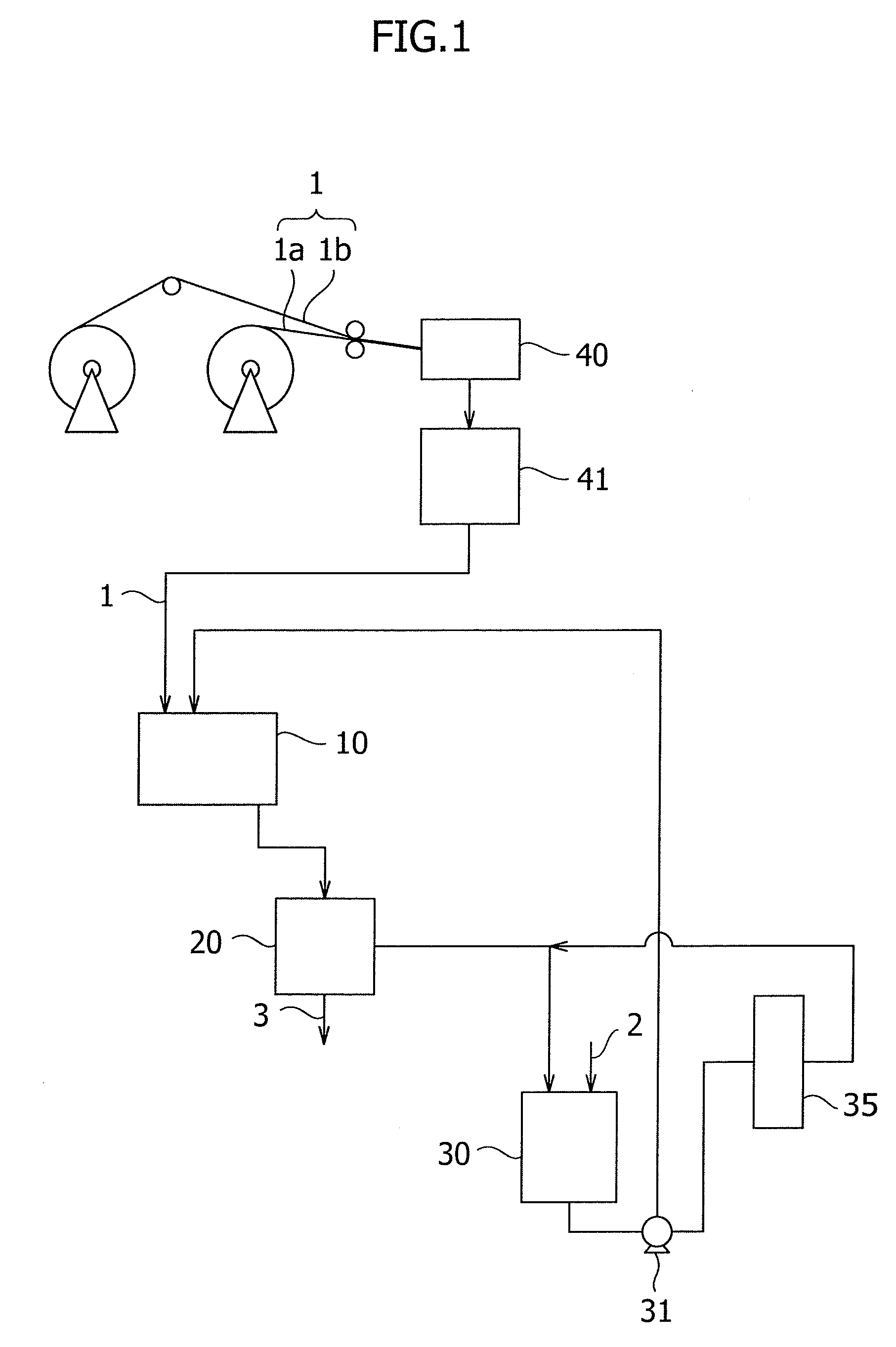Methods for producing alkali cellulose and cellulose ether
- Summary
- Abstract
- Description
- Claims
- Application Information
AI Technical Summary
Benefits of technology
Problems solved by technology
Method used
Image
Examples
example 1
[0060]Sheets of pulp A and pulp B were layered and processed together with a cutting machine to produce 10 mm-square mixed pulp chips AB.
[0061]A screw-conveyer type immersion tank comprising a screw conveyer having a screw diameter of 154 mm, a shaft diameter of 90 mm, a screw length of 1,500 mm and a screw pitch of 100 mm was provided and the screw conveyer was rotated at 25 rpm. The mixed pulp chips AB were fed into the screw-conveyer type immersion tank at a rate of 50 kg / hour. At the same time, an aqueous 49% by weight sodium hydroxide solution at 30° C. was fed into the tank at a rate of 1,700 L / hour from an inlet for sodium hydroxide. A centrifugal dehydrator of an extrusion plate type having a 0.2 mm slit screen, which was a continuous centrifugal separator, was installed at the end of the screw-conveyer type immersion tank. The centrifugal dehydrator continuously drained at a centrifugal effect of 1,000 a contact mixture between the mixed pulp chips and the aqueous sodium hy...
example 2
[0063]Pulp C and pulp D were used as raw materials. A ratio of an aqueous sodium hydroxide solution absorption rate of pulp D to that of pulp C (pulp D / pulp C) was 2.00.
[0064]Sheets of pulp C and pulp D were layered and processed together with a cutting machine to produce 10 mm-square mixed pulp chips CD.
[0065]A pipe having an inner diameter of 38 mm and a length of 10 m was provided and connected to a snake pump equipped with a hopper (Heishin Pump Works Co., Ltd., model NVL40PL) at the inlet of the pipe. An aqueous 49% by weight solution of sodium hydroxide at 40° C. was fed into the hopper at a rate of 1,100 L / hour. At the same time, the mixed pulp chips CD were fed at a rate of 50 kg / hour. The pipe was connected to a V-shaped disk press at the end of the pipe. The V-shaped disk press continuously drained a contact mixture between the mixed pulp chips and the aqueous sodium hydroxide solution, the contact mixture having been discharged from the pipe. A weight ratio of the alkalin...
example 3
[0067]Pulp E and pulp F were used as raw materials. A ratio of an aqueous sodium hydroxide solution absorption rate of pulp F to that of pulp E (pulp F / pulp E) was 4.00.
[0068]Sheets of pulp E and pulp F were layered and processed together with a cutting machine to produce 10 mm-square mixed pulp chips EF.
[0069]A screw-conveyer type immersion tank comprising a screw conveyer having a screw diameter of 154 mm, a shaft diameter of 90 mm, a screw length of 1,500 mm and a screw pitch of 100 mm was provided and the screw conveyer was rotated at 30 rpm. The mixed pulp chips EF were fed into the screw-conveyer type immersion tank at a rate of 50 kg / hour. At the same time, an aqueous 49% by weight sodium hydroxide solution at 20° C. was fed into the tank at a rate of 1,700 L / hour from an inlet for sodium hydroxide. A centrifugal dehydrator of a screw discharge type having a 0.2 mm slit screen, which was a continuous centrifugal separator, was installed at the end of the screw-conveyer type i...
PUM
 Login to View More
Login to View More Abstract
Description
Claims
Application Information
 Login to View More
Login to View More - R&D
- Intellectual Property
- Life Sciences
- Materials
- Tech Scout
- Unparalleled Data Quality
- Higher Quality Content
- 60% Fewer Hallucinations
Browse by: Latest US Patents, China's latest patents, Technical Efficacy Thesaurus, Application Domain, Technology Topic, Popular Technical Reports.
© 2025 PatSnap. All rights reserved.Legal|Privacy policy|Modern Slavery Act Transparency Statement|Sitemap|About US| Contact US: help@patsnap.com


